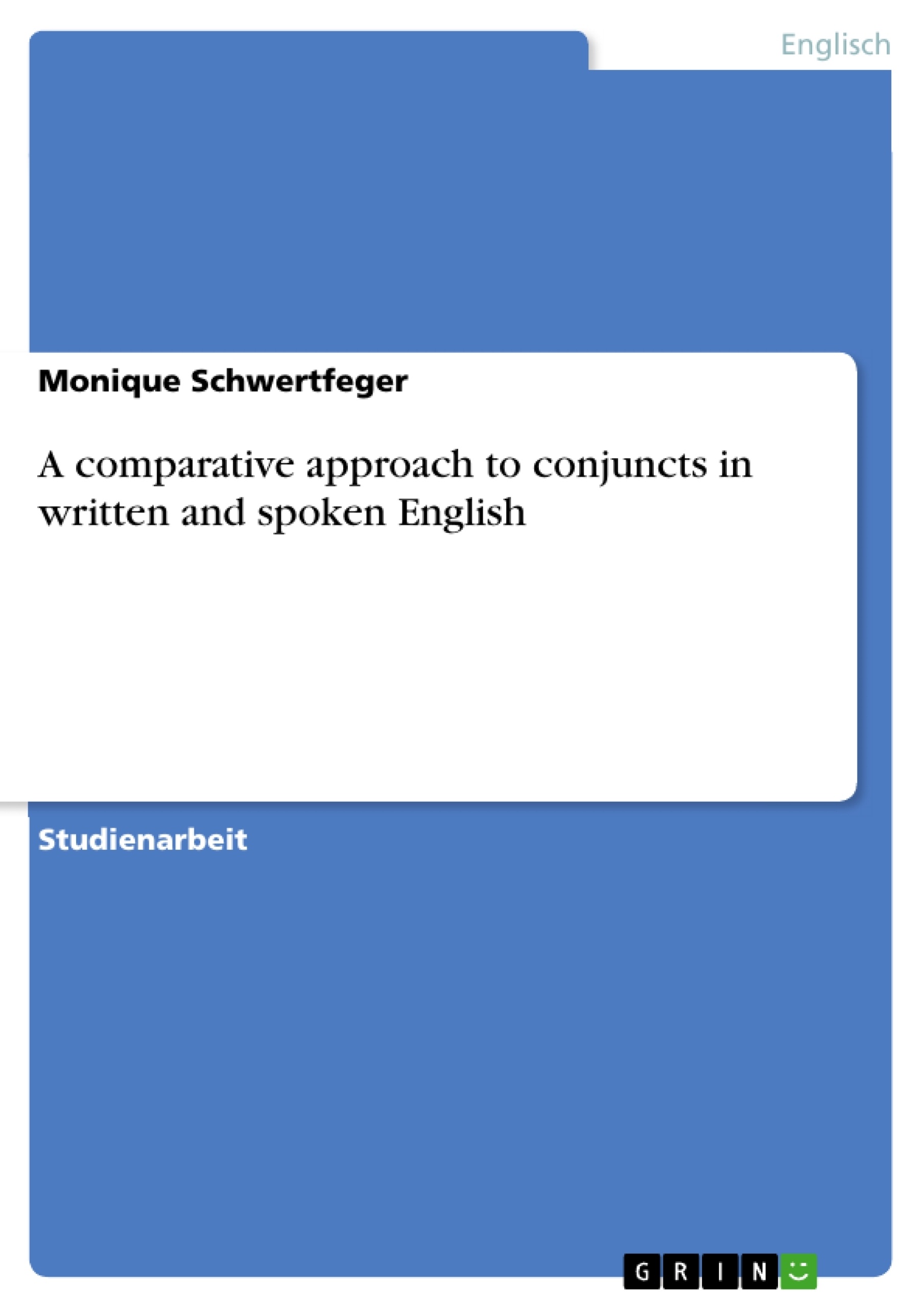An identical spoken and written language would be practically intolerable. If we spoke as we write we should find no one to listen: and if we write as we speak we should find no one to read. The spoken and written language must not be too near together, as they must not be too far apart. (T.S. Eliot) Speech and writing have different features. The paper explores different conjuncts concerning the usage in spoken and written English. The paper analyses the variation of conjuncts in speech and writing to understand the differences in usage.
Inhaltsverzeichnis
- 1. Ziele und Forschungsfragen
- 2. Kurzer Überblick über die Eigenschaften von Konjunkten
- 2.1. Die Semantik von Konjunkten
- 2.2. Realisierung der Konjunkte (syntaktische Realisierung)
- 2.3. Vergleich
- 3. Ansatz zu Konjunkten in geschriebenem und gesprochenem Englisch
- 3.1. Auflistung, additive Konjunkte
- 3.1.1. Furthermore in geschriebenem Englisch
- 3.1.2. Furthermore in gesprochenem Englisch
- 3.1.3. In addition in geschriebenem Englisch
- 3.1.4. In addition in gesprochenem Englisch
- 3.1.5. Moreover in geschriebenem Englisch
- 3.1.6. Moreover in gesprochenem Englisch
- 3.2. Inferentielle Konjunkte
- 3.2.1. In that case in geschriebenem Englisch
- 3.2.2. In that case in gesprochenem Englisch
- 3.2.3. Then in geschriebenem Englisch
- 3.2.4. Then in gesprochenem Englisch
- 4. Schlussfolgerung
- 5. Referenzen
Zielsetzung und Themenschwerpunkte
Die Arbeit untersucht die Unterschiede in der Verwendung von Konjunkten in geschriebener und gesprochener englischer Sprache. Ziel ist es, die Variationen in der Anwendung von Konjunkten zu analysieren und die Unterschiede im Gebrauch zu verstehen.
- Häufigkeit der Verwendung bestimmter Konjunkte in geschriebenem und gesprochenem Englisch.
- Wortklassen, die häufig vor und nach bestimmten Konjunkten auftreten.
- Positionierung von Konjunkten in geschriebenem und gesprochenem Englisch.
- Semantische Kategorien von Konjunkten (z.B. Aufzählung, Inferenz).
- Syntaktische Realisierung von Konjunkten.
Zusammenfassung der Kapitel
1. Ziele und Forschungsfragen: Dieses einleitende Kapitel stellt die Forschungsfrage nach den Unterschieden in der Verwendung von Konjunkten in gesprochenem und geschriebenem Englisch. Es wird die These aufgestellt, dass signifikante Unterschiede bestehen und diese untersucht werden sollen. Der Autor begründet die Relevanz der Untersuchung mit dem Unterschied zwischen gesprochener und geschriebener Sprache, und definiert die konkreten Forschungsfragen hinsichtlich Häufigkeit, Kollokationen und Wortordnung von Konjunkten.
2. Kurzer Überblick über die Eigenschaften von Konjunkten: Dieses Kapitel liefert eine allgemeine Einführung in Konjunkte als adverbiale Elemente, die zur Verknüpfung von Ideen und Sätzen dienen. Es beschreibt die Funktion von Konjunkten als Strukturelemente und erläutert die verschiedenen semantischen Gruppen von Konjunkten, z.B. Aufzählungskonjunkte, Inferenzkonjunkte und Kontrastkonjunkte. Die syntaktische Realisierung von Konjunkten wird ebenfalls kurz behandelt, wobei verschiedene Wortklassen und Satzstrukturen genannt werden.
3. Ansatz zu Konjunkten in geschriebenem und gesprochenem Englisch: Dieses Kapitel bildet den Kern der Arbeit und analysiert verschiedene Konjunkte (z.B. "furthermore", "in addition", "moreover", "in that case", "then") in Bezug auf ihren Gebrauch in geschriebenem und gesprochenem Englisch. Die Analyse umfasst die Häufigkeit des Auftretens, die Kollokationen und die Wortordnung. Es wird ein Vergleich zwischen den beiden Sprachformen durchgeführt, um die Unterschiede aufzuzeigen.
Schlüsselwörter
Konjunkte, gesprochenes Englisch, geschriebenes Englisch, Korpuslinguistik, Semantik, Syntax, Kollokationen, Wortordnung, Sprachvergleich, Adverbialien.
Häufig gestellte Fragen (FAQ) zu: Analyse von Konjunkten in geschriebenem und gesprochenem Englisch
Was ist der Gegenstand dieser Arbeit?
Diese Arbeit analysiert die Unterschiede in der Verwendung von Konjunkten in geschriebenem und gesprochenem Englisch. Der Fokus liegt auf der Häufigkeit, den Kollokationen und der Positionierung von Konjunkten in beiden Sprachformen.
Welche Konjunkte werden untersucht?
Die Analyse konzentriert sich auf die Konjunkte "furthermore", "in addition", "moreover", "in that case" und "then". Diese werden hinsichtlich ihrer Verwendung in geschriebenem und gesprochenem Englisch verglichen.
Welche Aspekte der Konjunkte werden betrachtet?
Die Untersuchung umfasst die Häufigkeit des Auftretens der Konjunkte, die Wortklassen, die häufig vor und nach ihnen stehen (Kollokationen), sowie ihre Positionierung im Satz (Wortordnung). Zusätzlich werden die semantischen Kategorien der Konjunkte (z.B. Aufzählung, Inferenz) und ihre syntaktische Realisierung analysiert.
Wie ist die Arbeit strukturiert?
Die Arbeit gliedert sich in fünf Kapitel: Kapitel 1 stellt die Forschungsfragen vor. Kapitel 2 bietet einen Überblick über die Eigenschaften von Konjunkten. Kapitel 3 bildet den Kern der Arbeit und analysiert die ausgewählten Konjunkte in geschriebenem und gesprochenem Englisch. Kapitel 4 enthält die Schlussfolgerung und Kapitel 5 listet die verwendeten Referenzen auf.
Welche Methodik wird angewendet?
Die Arbeit basiert auf korpuslinguistischen Methoden. Es wird ein Vergleich der Häufigkeit, der Kollokationen und der Wortordnung der untersuchten Konjunkte in Korpora für geschriebenes und gesprochenes Englisch durchgeführt.
Welche Schlussfolgerungen werden gezogen?
Die Arbeit stellt fest, dass signifikante Unterschiede in der Verwendung der untersuchten Konjunkte in geschriebenem und gesprochenem Englisch bestehen. Die genauen Ergebnisse der Häufigkeitsanalysen, Kollokationen und der Wortordnung werden im Kapitel 3 detailliert dargestellt.
Welche Schlüsselwörter beschreiben die Arbeit?
Schlüsselwörter sind: Konjunkte, gesprochenes Englisch, geschriebenes Englisch, Korpuslinguistik, Semantik, Syntax, Kollokationen, Wortordnung, Sprachvergleich, Adverbialien.
Welche Ziele verfolgt die Arbeit?
Ziel der Arbeit ist es, die Variationen in der Anwendung von Konjunkten in geschriebenem und gesprochenem Englisch zu analysieren und die Unterschiede im Gebrauch zu verstehen. Dies beinhaltet die Untersuchung der Häufigkeit bestimmter Konjunkte, ihrer Kollokationen und ihrer Positionierung im Satz.
- Citation du texte
- Monique Schwertfeger (Auteur), 2005, A comparative approach to conjuncts in written and spoken English, Munich, GRIN Verlag, https://www.grin.com/document/58453



